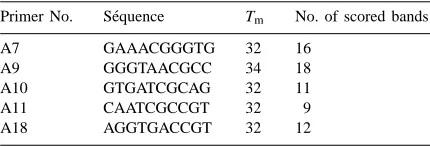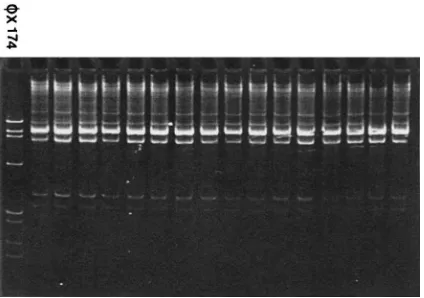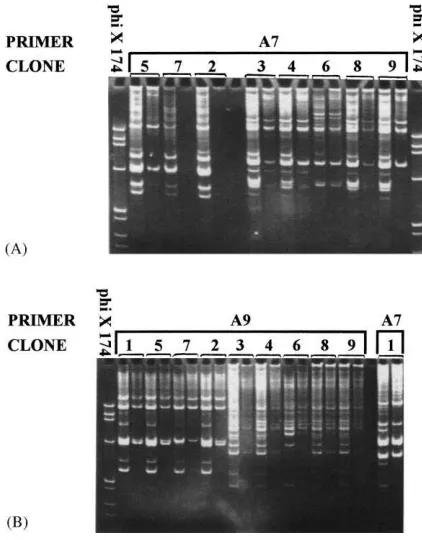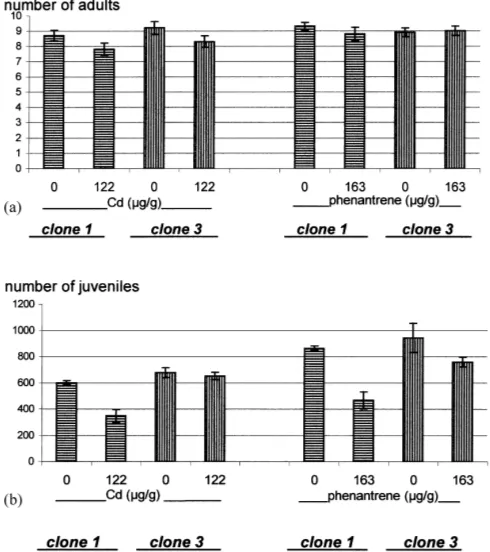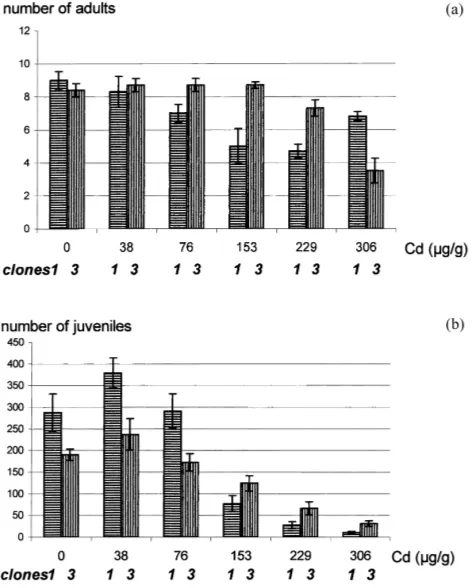Genetic polymorphism in nine clones of a parthenogenetic collembolan
used in ecotoxicological testing
P. Chenon, A. Rousset, Y. Crouau
∗Université Paul Sabatier, Laboratoire d’Ecologie Terrestre du C.N.R.S., 118 route de Narbonne, 31062 Toulouse, France
Received 28 August 1999; received in revised form 31 January 2000; accepted 2 February 2000
Abstract
Ecotoxicological tests are increasingly being used to evaluate the toxicity of a substance or mixture of substances towards soil fauna. One of these uses the parthenogenetic collembolan Folsomia candida to test for soil contamination, and this has been standardised in Europe. However, in such studies, it is important to know whether different laboratories use genetically close clones.
In this study, nine clones of the parthenogenetic collembolan F. candida, used in five laboratories, have been subtyped by amplification of random regions of genomic DNA using 10-base primers in the random-amplified polymorphic DNA polymerase chain reaction (RAPD-PCR). This differentiated these clones into three groups of four, four and one, respectively. Several hypotheses can be envisaged to explain these divergences between the populations of this parthenogenetic collembolan, notably the history of interlaboratory exchanges of clones. Ecotoxicological tests (mortality and reproduction) were undertaken to test the sensitivities to cadmium and phenantrene of two clones from different RAPD defined groups. These showed minor differences in sensitivities to both, but more extensive testing with five cadmium concentrations showed that the genetic clone does not affect the LOEC determination. There is no evidence of significant differences between clones throughout a concentration gradient of cadmium. © 2000 Elsevier Science B.V. All rights reserved.
Keywords: Folsomia candida; Genetic diversity; Parthenogenesis; Collembolan; RAPD fingerprints; Ecotoxicological test
1. Introduction
Ecotoxicological tests make up for the deficiencies of chemical analysis in the evaluation of the toxi-city of xenobiotics for natural biotopes. Although there exist many such tests for the aquatic environ-ment, relatively few have been developed using soil animal models. The only test that has been standard-ised for use in Europe is the mortality test on the
∗Corresponding author. Tel.:+33-05-61-55-6136; fax:+33-05-61-55-6196.
E-mail address: [email protected] (Y. Crouau)
earthworm Eisenia fetida (Riepert and Kula, 1996). It would be useful to have several tests based on soil arthropods; so various tests have been proposed (Fisher et al., 1994; Løkke et al., 1994; van Gestel and Doornekamp, 1994). Among these tests, the most advanced in development is a test of the chronic ef-fects of xenobiotics on the rate of reproduction of the collembolan Folsomia candida (Riepert and Kula, 1996).
Springtails are among the most abundant soil arthro-pods, their diet being composed mainly of litter, fungi and bacteria. The reproduction of F. candida is by parthenogenesis. Briefly, the F. candida reproduction
test consists of exposing juveniles to contaminated soil for approximately 1 month and comparing the rate of reproduction with that of control animals in non-contaminated soil.
Several European laboratories use this test and have attempted to standardise it in order to establish a European norm. Various studies have shown the importance of factors such as pH and the organic matter content of experimental soils (Sandifer and Hopkin, 1996; Crommentuijn et al., 1997; Peder-sen et al., 1997; van Gestel and van Diepen, 1997; Crouau et al., 1999). Preliminary results show con-siderable interlaboratory variations. A major hypoth-esis for this is that there are genetic differences in the clones used in the various laboratories. Such interclonal sensitivity variations have been shown for Daphnia magna, a parthenogenetic cladoceran used in aquatic ecotoxicological tests for mortal-ity (Baird et al., 1991) and reproduction (Münziger and Monicelli, 1991). Barber et al. (1990), Baird et al. (1990) and Soares et al. (1992) have also demonstrated clone–clone differences in respiration and mortality in D. magna exposed to cadmium and 3,4-dichloroaniline. The choice of partheno-genetic species for ecotoxicity testing has been ques-tioned by Forbes and Depledge (1992) and has led to much debate (Baird, 1992, 1993; Calow, 1992; Forbes and Forbes, 1993; Forbes and Depledge, 1993).
In order to see if the experimental differences between laboratories could be the result of genetic differences, polymorphisms in nine clones from five European laboratories using the F. candida repro-duction test were studied by Random Amplified Polymorphic DNA (RAPD). RAPD fingerprinting is a PCR-based molecular biological technique (Welsh and Mc Clelland, 1990; Williams et al., 1990) which requires only nanogram quantities of DNA. Hadrys et al. (1992) emphazised the high value of RAPD finger-printing for population genetic studies, offering major advantages such as its relative simplicity, speed and the virtually inexhaustible pool of possible genetic markers.
On the basis of the results of this RAPD study, the sensitivities of two genetically different clones to two xenobiotic compounds have been tested, in order to determine whether sensitivity differences can accom-pany genetic differences.
2. Materials and methods
2.1. Clones
The F. candida strains used in this study were from three German laboratories (clones 2, 3, 5, 7), from two Dutch laboratories (clones 4, 6, 8 and 9) and from our own laboratory (clone 1). The laboratories use these clones for the F. candida reproduction test. During the 2 months before the experiments, the F. candida clones were reared in darkness at 20◦C.
2.2. DNA preparation
DNA was extracted either by the standard phe-nol/chloroform procedure (Sambrook et al., 1989) or with the Chelex 100 technique (Walsh et al., 1991). Ten animals were ground in a micro-potter in 500ml Chelex 100 buffer (10%). Suspensions were incubated for 30 min at 55◦C to enable degradation of proteins by proteases, an additional incubation of 8 min at 100◦C denatured the remaining proteins, and after centrifugation for 2 min at 10,000 g the supernatant containing the DNA was stored at−20◦C.
2.3. RAPD
RAPD fingerprinting was resolved by polyacry-lamid gel electrophoresis. During the PCR reaction, parts of the target DNA are amplified using short oligonucleotide primers. In this way sample-specific patterns of DNA fragments are generated without prior knowledge of the nucleotide sequence and eighteen 10mer primers (Eurogentec) were tested with DNA samples of F. candida. Five primers which produced the highest numbers of scorable fragments were cho-sen (Table 1). RAPD was performed by using 1ml of
Table 1
Base sequences, melting temperatures (Tm) and total number of
scored bands of the five primers used for the PCR amplifications
Primer No. S´equence Tm No. of scored bands
A7 GAAACGGGTG 32 16
A9 GGGTAACGCC 34 18
A10 GTGATCGCAG 32 11
A11 CAATCGCCGT 32 9
dNTP 2.5 mM, 1.5ml of MgCl2 25 mM, 20 ng primer and 0.5 units Taq polymerase (final volume, 25ml). Reactions were cycled 40 times: 10 s at 95◦C, 30 s at 36◦C and 1 min at 72◦C. The amplification products were resolved on 7% polyacrylamide gel (7 V/cm, 4 h), stained subsequently with ethidium bromide and visualized by illumination with ultraviolet light.
2.4. Data analysis
To assess the genetic variations between the differ-ent clones of F. candida, phenetic analysis was used. This consisted of constructing trees from the similar-ity characteristics which, in the present case, were the presence or absence of amplification fragments in the various lanes. Only reproducible amplification prod-ucts were scored — non reproducible fragments usu-ally appeared as faint bands on the gels. A data matrix was formed by scoring the occurrence of a specific band as 1 and its absence as 0. By pooling the servations for all the primers tested, a matrix was ob-tained and analysed with the Unweighted Pair-Group Method for Arithmetic Averages (UPGMA) using the ‘RAPDPLOT’ program (Kambhampati et al., 1992). The program provides a similarity coefficient which corresponds to the sum of the means of fragments common for each pairing divided by the total number of pairings. A graphical representation of the results was obtained using the Phylip 3.5 C program (Felsen-stein, 1992).
2.5. Ecotoxicological tests
The ecotoxicological tests consist of exposing ju-veniles (ten 10–12 day old juju-veniles per pot, nine pots per concentration) to contaminated soil and comparing the rate of reproduction with that of animals placed in non-contaminated control soil (ISO-Standard 11268-1: sphagnum peat, 10%; kaolinite clay, 20%; quartz sand, 70%; CaCO3to bring the pH to 6±0.5). At the end of the period of exposure to the con-taminated soil (33–34 days, 20±1◦C, photoperiod 12 h/12 h under lighting of about 400 lux), adults and juveniles are counted. The Wilcoxon’s two-sample test was used to detect significant differences from the blank (LOEC: lowest observed effect concentration); the EC50 values were calculated by means of the
maximum likelihood-probit procedure (Toxcalc 5.0 software). See Riepert and Kula (1996) and Crouau et al. (1999) for a more detailed protocol of the test.
The effects of cadmium (122mg/g) and of phenantrene (163mg/g) were tested on two clones (clones 1 and 3). The concentrations were between the LOEC and the No Observed Effect Concentration (NOEC — and thus optimal for demonstrating clone differences) in previous studies using six concentra-tions (Crouau et al., 1999). The test was repeated for cadmium with five other concentrations in order to comply with the conditions defined by Riepert and Kula (1996).
3. Results
3.1. RAPD
The fragment patterns obtained during the RAPD amplification showed high reproducibility for a given clone and a given primer (Fig. 1). The bands observed on electrophoresis of the DNA extracted with the phenol/chloroform method were also observed with the DNA extracted by means of Chelex 100. The Chelex technique, however, gave additional bands (Fig. 2A and B) because it has a greater DNA extrac-tion efficiency. The electrophoretic patterns show that
Fig. 2. Fragments amplified using primers A7 (Fig. 2A), A7 and A9 (Fig. 2B) on chelex (left lane) and phenol/chloroform (right lane) extracted DNA.
the clones can be classified into three groups (Fig. 2); the phenogram (Fig. 3) which we obtained after processing the data confirmed this separation into
Fig. 3. Similarity percentage dendrogram obtained by UPGMA analysis of the RAPD fingerprints of DNA of nine clones of F. candida. The nine clones are separated into three Groups A, B and C.
three groups:
Group A: clones 1, 2, 5, and 7. Group B: clones 3, 4, 8 and 9. Group C: just clone 6.
Group C shows a similarity percentage of 70 with Group B and of 0 with A.
These percentages are obtained with five markers and could be different with another set of markers. These results show that these markers are well adapted to differentiate F. candida clones.
3.2. Ecotoxicological tests
The two clones (1 and 3) used for sensitivity tests were chosen from the two main groups delimited by the RAPD study.
3.2.1. One concentration test
In the concentrations studied, neither xenobiotic compound affected mortality of either clone (Fig. 4a). However, reproductive fitness was significantly reduced in clone 1 but not in clone 3 (Fig. 4b).
3.2.2. Five concentrations test
The cadmium experiment with five Cd concentra-tions produced an estimate of 153mg/g (p≤0.05) for the LOEC (reproduction) for both clones and two slightly different estimates for the EC50: 129mg/g (119–138) for clone 1 and 184mg/g (141–224) for clone 3 (Fig. 5).
4. Discussion
Adapted populations may exclude heavy metals from the body or accumulate them in special organs (Humbert, 1978; Hopkin, 1989;), so that results of monitoring studies will be biased.
Fig. 4. a and b. The effects of cadmium and phenantrene on mortality (4a) and reproduction (4b) in clones 1 and 3 of F. candida. (horizontally striped bars: clone 1; vertically striped bars: clone 3). Vertical bars: S.E.M. (n=9).
According to Münziger and Monicelli (1991), “two laboratories which carry out the D. magna tests under identical conditions, obtain different results solely on account of the different clones of Daphnia used. This may even influence the setting of legislative admissi-ble limits for the involved heavy metals”. They recom-mend that the tests be performed on several clones with different sensitivities. In the opinion of Baird (1992), the clones used by the various laboratories should be defined with respect to their genotypes.
The study showed that the RAPD technique with Chelex 100 DNA extraction is well suited to the ge-netic characterisation of the clones of the partheno-genetic springtail F. candida used in ecotoxicolog-ical testing. From a methodologecotoxicolog-ical point of view, the most important factor to obtain comparable re-sults is to maintain constant conditions during am-plification, especially concerning the concentrations of Mg2+, primers (Kernodle et al., 1993) and poly-merase (Brikun et al., 1994). The study also showed
Fig. 5. a and b. Dose-response relationships for the effect of cadmium on adult survival (5a) and reproduction in clones 1 and 3 of F. candida. Vertical bars: S.E.M. (n=9).
separation was not found for clone 9 (96% similar-ity) which was taken in the Paris area (1981, Brunoy), i.e. as far from Berlin and the Netherlands as clone 6. The origin of clone 3 remains unknown but its posi-tion on the phenogram suggests it originated from the Netherlands or was supplied by one of the laboratories working with clones 4 and 8.
These results do raise the question of the genetic homogeneity of the various clones used in laborato-ries carrying out ecotoxicological tests, particularly ring-tests, with parthenogenetically reproducing ani-mals (the springtail F. candida but also, for freshwater tests, the crustacean D. magna). Concerning F. can-dida, a comparative study of the sensitivity (LC50 and reproduction) of three clones to three xenobiotics (cad-mium, chlorpyrifos and triphenyltine hydroxide) car-ried out by Crommentuijn et al. (1995) showed ‘small but significant’ differences in sensitivity for one of the
three xenobiotics (CPF). Our ecotoxicological tests of the two genetically different clones of F. candida show that within the zone between LOEC and NOEC the strains show different sensitivities. Using normal test conditions with concentrations predetermined by mor-tality studies, the same LOEC value would be found for both clones.
Acknowledgements
The authors are indebted to Dr. S.P. Hopkin for com-ments on the manuscript, Dr. F. Riepert for providing advice at the beginning of our work on the F. candida reproduction test and Dr. J. Clayton and M. Winter-ton for correcting the English. We thank Dr. C.A.M. Van Gestel (Amsterdam University), Dr. F. Heim-bach (BAYER), Dr. R. Heusel (AgrEvo), Dr. Jatzek (BASF), Dr. R.A.E. Knoben (Witteveen/Bos) and Dr. Riepert (Institüt für Okotoxikologie im Pflanzen-schutz, Berlin) who kindly supplied the clones of F. candida. This study was supported by the ‘Agence de l’Environnement et de la Maˆıtrise de l’Energie’.
References
Baird, D.J., 1992. Predicting population response to pollutants: in praise of clones. A comment on Forbes and Depledge. Func. Ecol. 6, 616–617.
Baird, D.J., 1993. Can toxicity testing contribute to ecotoxicology? Func. Ecol. 7, 510–511.
Baird, D.J., Barber, I., Calow, P., 1990. Clonal variation in general responses of Daphnia magna Straus to toxic stress I. Chronic life-history effects. Func. Ecol. 4, 399–407.
Baird, D.J., Barber, I., Bradley, M., Soares, A.M.V., Calow, P., 1991. A comparative study of genotype sensitivity to acute toxic stress using clones of Daphnia magna Straus. Ecotoxicol. Environ. Safety 21, 257–265.
Barber, I., Baird, D.J., Calow, P., 1990. Clonal variation in general responses of Daphnia magna Straus to toxic stress II. Physiological effects. Func. Ecol. 4, 409–414.
Brikun, I., Suziedelis, K., Berg, D.E., 1994. DNA sequence divergence among derivates of Escherichia coli K-12 detected by arbitrary primer PCR (random amplified polymorphic DNA) fingerprinting. J. Bacteriol. 176, 1673–1682.
Calow, P., 1992. The three Rs of ecotoxicology. Func. Ecol. 6, 617–619.
Crommentuijn, T., Stäb, J.A., Doornekamp, A., Estoppey, O., van Gestel, C.A.M., 1995. Comparative ecotoxicity of cadmium, chlorpyrifos and triphenyltin hydroxide for four clones of the parthenogenetic collembolan Folsomia candidain an artificial soil. Func. Ecol. 9, 734–742.
Crommentuijn, T., Doornekamp, A., van Gestel, C.A.M., 1997. Bioavailability and ecological effects of cadmium on F. candida (Willem) in an artificial soil substrate as influenced by pH and organic matter. Appl. Soil Ecol. 5, 261–271.
Crouau, Y., Chenon, P., Gisclard, C., 1999. The use of Folsomia candida (Collembola, Isotomidae) for the bioassay of xenobiotic substances and soil pollutants. Appl. Soil Ecol. 12, 103–111. Dallai, R., Fanciulli, P.P., Petrucci, R., 1986. Enzyme diversity in
the genus Bilobella (Insecta, Collembola). Rev. Ecol. Biol. Soil 23, 333–348.
Felsenstein, J., 1992. Phylogenies from restriction sites: a maximum-likelihood approach. Evolution 46, 159–173. Fisher, E., Majer, J., Hornung, E., Farkas, S., Molnar, L., 1994.
Sublethal effects of soil and food pollutants on the growth of Porcellio scaber (Latr., 1814) (Isopoda: Porcellionidae). In: Kula, H., Heimbach, U., Løkke, H. (Eds.), Progress Report 1994 of Secofase, 3rd technical report, Denmark, pp. 139–158. Forbes, V.E., Depledge, M.H., 1992. Predicting population response to pollutants: the significance of sex. Func. Ecol. 67, 376–381.
Forbes, V.E., Depledge, M.H., 1993. Testing vs research in ecotoxicology: a response to Baird and Calow. Func. Ecol. 7, 509–510.
Forbes, V.E., Forbes, T.L., 1993. Ecotoxicology and the power of clones. Func. Ecol. 7, 511–512.
Grimnes, K.A., 1986. Esterases in F. candida (Collembola: Isotomidae). Characterization of enzymes among partheno-genetic strains. Comp. Biochem. Physiol. 83C (2), 359–363. Hadrys, H., Balick, M., Schierwater, B., 1992. Applications of
random amplified polymorphic DNA (RAPD) in molecular ecology. Mol. Ecol. 1, 55–63.
Hopkin, S.P., 1989. Ecophysiology of Metals in Terrestrial Invertebrates. Elsevier Applied Science, London, NY. Humbert, W., 1978. Cytochemistry and X-ray microprobe
analysis of the midgut of Tomocerus minor Lubbock (Insecta, Collembola) with special reference to the physiological significance of the mineral concretions. Cell Tiss. Res. 187, 397–416.
Kambhampati, W.C., Blake, D., Rai, K.S., 1992. Random amplified polymorphic DNA (RAPD) of mosquito species and populations (Diptera, Culicidae): techniques, statistical analysis and application. J. med. Entomol. 29, 939–945.
Kernodle, S.P., Cannon, R.E., Scandalios, J.G., 1993. Concentration of primer and template qualitatively affects products in random-amplified polymorphic DNA PCR. Biotechniques 14, 362–364.
Løkke, H., Krogh, P.H., Folker-Hansen, P., Holmstrup, M., 1994. Sublethal toxicity test with the gamasid mite Hypoaspis aculeifer Canestrini (Acari: Gamasida) preying on the Collembolan Folsomia fimetaria Linné (Collembola: Isotomidae). In: Kula, H., Heimbach, U., Løkke, H. (Eds.), Progress Report 1994 of: Secofase, 3rd technical report, Denmark, pp. 13–23.
Münziger, A., Monicelli, F., 1991. A comparison of the sensitivity of three Daphnia magna populations under chronic heavy metal stress. Ecotoxicol. Environ. Safety 22, 24–31.
Pedersen, M.B., Temminghoff, E.J.M., Marinussen, M.P.J.C., Elmegaard, N., van Gestel, C.A.M., 1997. Copper accumulation and fitness of Folsomia candida Willem in a copper contaminated sandy soil as affected by pH and soil moisture. Appl. Soil Ecol. 6, 135–146.
Posthuma, L., 1990. Genetic differentiation between populations of Orchesella cincta (Collembola) from heavy metal contaminated sites. J. Appl. Ecol. 27, 609–622.
Riepert, F., Kula, C., 1996. Development of laboratory methods for testing effects of chemicals and pesticides on Collembola and earthworms. Mitteilungen aus der Biologischen Bundesanstalt für Land- und Forstwirtschaft, 82 pp.
Sambrook, J., Fritsch, E.F., Maniatis, T., 1989. Molecular Cloning, 2nd Edition. Cold Spring Harbor Laboratory Press.
Sandifer, R.D., Hopkin, S.P., 1996. Effects of pH on the toxicity of cadmium, copper, lead and zinc to Folsomia candida Willem, in a standard laboratory test system. Chemosphere 33 (12), 2475–2486.
Soares, A.M.V.M., Baird, D.J., Calow, P., 1992. Interclonal variation in the performance of Daphnia magna Straus in chronic bioassays. Environ. Toxicol. Chem. 11, 1477–1483. van Gestel, C.A.M., Doornekamp, A., 1994. Sublethal toxicity
test with the oribatid mite Platynothrus peltifer (koch, 1839) ( Oribatid: Acari). In: Kula, H., Heimbach, U., Løkke, H.
(Eds.), Progress Report 1994 of Secofase, 3rd technical report, Denmark, pp. 63–80.
van Gestel, C.A.M., van Diepen, A.M.F., 1997. The influence of soil moisture content on the bioavailability and toxicity of cadmium for Folsomia candida Willem (Collembola: Isotomidae). Ecotoxicol. Environ. Safety 36, 123–132. Walsh, P.S., Metzger, D.A., Higuchi, R., 1991. Chelex 100 as a
medium for simple extraction of DNA for PCR-based typing for forensic material. Biotechniques 10, 510–513.
Welsh, J., Mc Clelland, M., 1990. Fingerprinting genomes using PCR with arbitrary primers. Nucl. Acids Res. 18, 7213– 7218.
